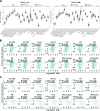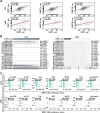Identification of DNA methylation-regulated WEE1 with potential implications in prognosis and immunotherapy for low-grade glioma
- PMID: 39213054
- PMCID: PMC11380252
- DOI: 10.3233/CBM-230517
Identification of DNA methylation-regulated WEE1 with potential implications in prognosis and immunotherapy for low-grade glioma
Abstract
Background: WEE1 is a critical kinase in the DNA damage response pathway and has been shown to be effective in treating serous uterine cancer. However, its role in gliomas, specifically low-grade glioma (LGG), remains unclear. The impact of DNA methylation on WEE1 expression and its correlation with the immune landscape in gliomas also need further investigation.
Methods: This study used data from The Cancer Genome Atlas (TCGA), Chinese Glioma Genome Atlas (CGGA), and Gene Expression Omnibus (GEO) and utilized various bioinformatics tools to analyze gene expression, survival, gene correlation, immune score, immune infiltration, genomic alterations, tumor mutation burden, microsatellite instability, clinical characteristics of glioma patients, WEE1 DNA methylation, prognostic analysis, single-cell gene expression distribution in glioma tissue samples, and immunotherapy response prediction based on WEE1 expression.
Results: WEE1 was upregulated in LGG and glioblastoma (GBM), but it had a more significant prognostic impact in LGG compared to other cancers. High WEE1 expression was associated with poorer prognosis in LGG, particularly when combined with wild-type IDH. The WEE1 inhibitor MK-1775 effectively inhibited the proliferation and migration of LGG cell lines, which were more sensitive to WEE1 inhibition. DNA methylation negatively regulated WEE1, and high DNA hypermethylation of WEE1 was associated with better prognosis in LGG than in GBM. Combining WEE1 inhibition and DNA methyltransferase inhibition showed a synergistic effect. Additionally, downregulation of WEE1 had favorable predictive value in immunotherapy response. Co-expression network analysis identified key genes involved in WEE1-mediated regulation of immune landscape, differentiation, and metastasis in LGG.
Conclusion: Our study shows that WEE1 is a promising indicator for targeted therapy and prognosis evaluation. Notably, significant differences were observed in the role of WEE1 between LGG and GBM. Further investigation into WEE1 inhibition, either in combination with DNA methyltransferase inhibition or immunotherapy, is warranted in the context of LGG.
Keywords: DNA methylation; WEE1; immunotherapy; low-grade glioma; prognosis.
Conflict of interest statement
No commercial or financial relationships could be construed as potential conflicts of interest by the authors.
Figures









Similar articles
-
DSN1 may predict poor prognosis of lower-grade glioma patients and be a potential target for immunotherapy.Cancer Biol Ther. 2024 Dec 31;25(1):2425134. doi: 10.1080/15384047.2024.2425134. Epub 2024 Nov 18. Cancer Biol Ther. 2024. PMID: 39555702 Free PMC article.
-
Recurrence- and Malignant Progression-Associated Biomarkers in Low-Grade Gliomas and Their Roles in Immunotherapy.Front Immunol. 2022 May 23;13:899710. doi: 10.3389/fimmu.2022.899710. eCollection 2022. Front Immunol. 2022. PMID: 35677036 Free PMC article.
-
CKS2 (CDC28 protein kinase regulatory subunit 2) is a prognostic biomarker in lower grade glioma: a study based on bioinformatic analysis and immunohistochemistry.Bioengineered. 2021 Dec;12(1):5996-6009. doi: 10.1080/21655979.2021.1972197. Bioengineered. 2021. PMID: 34494924 Free PMC article.
-
WEE1 inhibition in cancer therapy: Mechanisms, synergies, preclinical insights, and clinical trials.Crit Rev Oncol Hematol. 2025 Jul;211:104710. doi: 10.1016/j.critrevonc.2025.104710. Epub 2025 Apr 3. Crit Rev Oncol Hematol. 2025. PMID: 40187712 Review.
-
Epigenetic reprogramming and antitumor immune responses in gliomas: a systematic review.Med Oncol. 2025 May 16;42(6):213. doi: 10.1007/s12032-025-02760-y. Med Oncol. 2025. PMID: 40380049 Review.
References
-
- Lapointe S., Perry A. and Butowski N.A., Primary brain tumours in adults, Lancet (London, England) 392 (2018), 432–446. - PubMed
MeSH terms
Substances
LinkOut - more resources
Full Text Sources
Medical
Molecular Biology Databases

